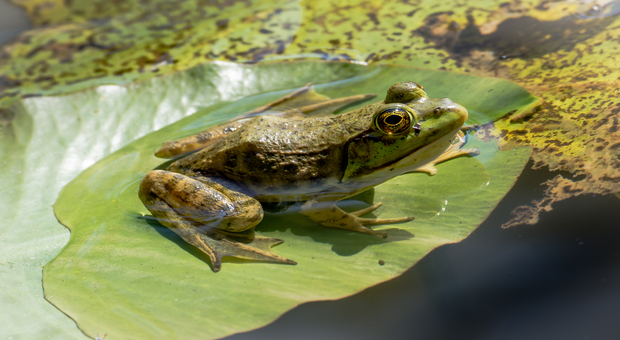When bugging out into the woods, camping near a marsh on the shore of a small lake makes a lot of sense for the keen survivalist.
Such a location will provide you with resources like food and water without having to spend too much energy to acquire them. If you like to go camping, you’ve probably heard an occasional deep-pitched croak. What you’ve heard is the call of the largest American frog—the bullfrog. That distinctive sound can become your salvation in an emergency situation when food is scarce.
The bullfrog was a staple food in the diet of indigenous people of North America. In fact, there are historical records showing how the Richibucto Micmac, Onondaga Iroquois, and Micmac tribes used the bullfrog. Although it was not their food of choice and there’s no telling if they particularly like it or not, they ate frogs when other food was unobtainable.
They had different ways of consuming the frogs, and only Richibucto Micmac preferred the legs of the bullfrog. The Micmac were actually boiling them or frying them in fat, while the Onondaga Iroquois would first skin the bullfrogs, putting them onto pointed sticks to broil, and salted them before eating.
Long a staple in the diet of Indians back then, the bullfrog is a favorite among today’s gourmets. The frog’s hind legs are referred to as “drumsticks,” providing the diner with large morsels of delicious white meat. Some folks describe the taste as being similar to chicken, while others argue it is more like fish.
After having my fair share of bullfrogs, I can tell you that, frog legs are frog legs, and nothing comes close to tasting as good.
The range of the bullfrog
The mighty bullfrog ranges from the Atlantic Coast to Eastern Colorado and New Mexico, and south from southern Canada to northeast Mexico. The bullfrog may also be found in abundance in many parts of the Rockies, and in Western states where it has been introduced.
The bullfrog is a highly aquatic animal that lives in or near a body of water that is largely independent of rainfall. The frog prefers the quiet waters of marshes, or the backwaters and edges of ponds, lakes, and streams where a thick growth of cattails or other aquatic vegetation provides concealment. The bullfrog will venture away from permanent bodies of water only in exceptionally wet weather.
During the day, bullfrogs are extremely wary and difficult to approach, but at night are found readily by searching for their highly reflective eyes.
All you need is a good flashlight and a little patience to catch a few bullfrogs. I can tell you that light seem to have a paralytic effect on the bullfrog. The bullfrog can be easily caught, when dazzled by a bright beam. Old-time frog hunters use their hands to grab a light-dazed frog, but nowadays, the most effective means of capture is to employ a gig.
Gigs for Frogging
When it comes to frogging, there are two types of gigs—the spear gig, which is actually the most preferred one, and the clamp gig.
With the spear gig, the hunter stabs a frog, which is held on the spear by barbs on its two, three or four times.
Though common, the spear gig offers no advantage when the frog is floating on the water, or lying among soft reeds where it cannot be pinned down. Spear gigs also have been known to glance off the hard, bony back of a frog without penetration.
The clamp gig is the favorite of many experienced frog hunters. It allows the hunter to snatch a frog out of almost any situation and it assures a meal for the day. When cocked, the spring action is sensitive to touch, and the gig’s jaws will snap shut when the trigger prongs make contact with a frog.
Frogging takes a bit of finesse and care must be taken not to set off the gig accidentally by hitting a twig or reed while working it toward a frog. When approaching a frog from the rear, the side or from above, the creature is relatively easy to gig. A frog has lightning-fast reflexes, however, and will leap into the water, out of sight and range, at the slightest movement.
Remember, the position of the frog’s eyes on its head gives it an almost 360-degree viewing capability. Head-on, the frog is even more difficult to capture. He presents a smaller target and has been known to jump right out of the jaws of a closing clamp gig.
There are all sorts of gigs available on the market, and there are even complete packages with lanterns/flashlights attached on the stick of the gig. Such setup provides better accuracy and much more maneuverability.
Alternatives to catching bullfrogs
Over the years, improvisation found its way into frogging and people are using large dip nets, archery, or even a rifle for hunting bullfrogs. For thick bush areas where a gig is almost impossible to use, and the bullfrog can be reached, a .22 caliber is often used.
It may sound easy to hunt bullfrogs with a rifle, but the key to success is to place the bullet squarely between the frog’s eyes. A brain shot causes the frog to stiffen out straight as a board. To be fair, it’s a basic principle of survival hunting. Just like with any other animal, there is a risk of losing a wounded frog. Use judgment before shooting to save ammo and secure a meal.
At night, whether walking a pond’s edge or hunting from a boat, a good light capable of throwing a strong spot beam is essential to a successful hunt. While some hunters use hand-held flashlights, most prefer a spotlight or a high-beam lantern. Under survival conditions, a torch with an improvised reflector —perhaps cut from a tin can, or some aluminum foil—will suffice.
Hunting the American bullfrog
The hunter begins by casting his beam slowly along the water’s edge to pick up the golden-green reflection of the frog’s eyes. This sounds easy, doesn’t it?
However, there are numerous aquatic insects and animals with reflective eyes that can confuse an inexperienced frog hunter. Common spiders, known as water striders, have been responsible for untold numbers of false stalks. Just like with any other survival skill, only experience leads to the determination of which eyes belong to what creature. The deep croak of a bullfrog can be used as an audio homing beacon. However, just because those hearty croaks aren’t being sounded does not mean bullfrogs cannot be found.
Frogs can be classified as strange creatures due to their unpredictable behavior. One night they’ll croak until dawn, other nights they may call only sporadically, and some nights they won’t croak at all. Hunting frogs during the day is tough, and you need sharp eyes and a good knowledge of the forage area.
Frogs generally seek heavy cover during the day, and the camouflage pattern of their skin makes them nearly impossible to detect. The most productive hunting in daylight is on a small pond, or in a shallow, grassy marsh where cover is sparse. Frog hunters should be aware that when first seized, bullfrogs may play possum. They will often hang limp and motionless, however, be alert for sudden recovery. You can lose your frog in a split second. Use a cold, damp sack to store your captured bullfrogs and make sure it has the mouth securely tied.
Legislation
In an emergency situation, you won’t give a damn about the legislation in effect. However, the hunting and fishing regulations must be respected during “times of peace.” There’s an open season for the bullfrog, and in general, it ranges from June to November. This may depend from state to state, and you should check the laws in effect in your area before bagging bullfrogs.
The species is globally widespread and the IUCN (International Union for Conservation of Nature) has included the bullfrog among the 100 worst invasive species in the world. Although bullfrogs are labeled as an invasive species and are often considered a pest, you can’t go hunting bullfrogs and decimate an entire species because they are thriving in certain areas.
Cooking
To clean a frog for eating, first, kill it with a sharp blow to the head. Use pliers to peel off the skin and remove the webbed feet with a knife, or snip them off with mull wire cutters.
Most people save only the large hind legs, but on larger frogs, forelegs and back provide some meat. As a survivalist, you can’t be peaky, and you need to consume as much of the animal as possible. Frog legs are best fried after being rolled in flour-and-egg batter, but they may be broiled or baked. It really depends on your cooking setup, resources and developing scenario.
It is also important to specify that the bullfrog has two cousins that are also edible. The Leopard Frog and the Green Frog can be added to your survival food list too. Though not as large as the bullfrog, both can provide the hunter and his family a meal.
Conclusion
For survivalists, it is important to acknowledge that frogs are seasonal and they won’t provide a meal all year round. They disappear with the first sign of cold weather, then return in mid-spring, and may be hunted through autumn. The best hunting is in late spring and early summer. During the winter months, the American bullfrog hibernates in the mud at the bottom of ponds and lakes, and they are impossible to catch.
Frogging is for some a hobby that gets in the blood. Once a hunter has caught 3 or 4 sizeable bulls, and fried them up in a hot skillet, he’ll return for seconds. As survival food, the bullfrog is readily available and will prove a tasty, nutritious treat when nothing else is available.











Tim Galli | April 18, 2019
|
Hi,
Great article, though here in Australia we have plagues of Cane Toads. They have poison glands on their back which have killed lots of wildlife.
Do you think these would be safe for eating?
Bob L. | April 18, 2019
|
Good white meal on those frog legs. I like them fried. No, I don’t think frog meat tastes like chicken, but it’s a good mild flavor.
The photo accompanying this article is actually of a smaller Leopard Frog, not a Bull Frog.
rod Clark | April 19, 2019
|
I have been around cottages since I was 4, and I’m 71 now. I love to fall asleep to the sound of frogs croaking in the night. My first wife thought all the neighbour’s had noise airconditoners. My second wife hated the sound so we ended up sleeping in different bedrooms. I got the one facing the lake with the breeze all night & the frogs, while she slept in a hot bedroom on the leftward side, toward the road. I think I miss the frogs more than her.
Tim H. | April 20, 2019
|
We catch frogs using a pole, fishing line, and scrap of a rag on the hook. The frogs seem to mistake the rag for an flying insect and hook themselves by grabbing it.